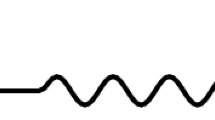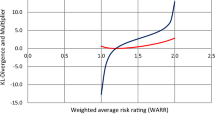Abstract
Modeling the dependence of credit ratings is an important issue for portfolio credit risk analysis. Multivariate Markov chain models are a feasible mathematical tool for modeling the dependence of credit ratings. Here we develop a flexible multivariate Markov chain model for modeling the dependence of credit ratings. The proposed model provides a parsimonious way to capture both the cross-sectional and temporal associations among ratings of individual entities. The number of model parameters is of the magnitude O(sm 2 + s 2 m), where m is the number of ratings categories and s is the number of entities in a credit portfolio. The proposed model is also easy to implement. The estimation method is formulated as a set of s linear programming problems and the estimation algorithm can be implemented easily in a Microsoft EXCEL worksheet, see Ching et al. Int J Math Educ Sci Eng 35:921–932 (2004). We illustrate the practical implementation of the proposed model using real ratings data. We evaluate risk measures, such as Value at Risk and Expected Shortfall, for a credit portfolio using the proposed model and compare the risk measures with those arising from Ching et al. IMRPreprintSeries (2007), Siu et al. Quant Finance 5:543–556 (2005).
Similar content being viewed by others
References
Albanese, C. (1997). Credit exposure, diversification risk and coherent VaR. Preprint, Department of Mathematis, University of Toronto.
Bedford T. J., Cooke R. (2001) Probabilistic risk analysis: Foundations and methods. Cambridge University Press, Cambridge
Ching W. K., Ng M. K., Fung E. S. (2004) Building higher-order Markov chain models with EXCEL, EXCEL DEMO. International Journal of Mathematical Education in Science and Engineering 35: 921–932
Ching, W. K., Siu, T. K., Li, L. M., & Li, W. K. (2007). A parsimonious multivariate Markov chain model for credit risk. IMRPreprintSeries.
Gini, C. W. (1912). Variability and mutability, contribution to the study of statistical distributions and relations. Studi Economico-Giuridici della R. Universita de Cagliari.
Kijima M., Komoribayashi K., Suzuki E. A. (2002) Multivariate Markov model for simulating correlated defaults. Journal of Risk 4(4): 1–32
King, J. L. (2002). Measurement and modelling operational risk. Wiley.
Morgan, J. P. (1996). RiskMetrics—Technical Document. 4th ed., New York.
Siu T. K., Ching W. K., Fung E., Ng M. (2005) On a multivariate Markov chain model for credit risk measurement. Quantitative Finance 5: 543–556
Author information
Authors and Affiliations
Corresponding author
Rights and permissions
About this article
Cite this article
Fung, E.S., Siu, T.K. A Flexible Markov Chain Approach for Multivariate Credit Ratings. Comput Econ 39, 135–143 (2012). https://doi.org/10.1007/s10614-011-9258-y
Accepted:
Published:
Issue Date:
DOI: https://doi.org/10.1007/s10614-011-9258-y




